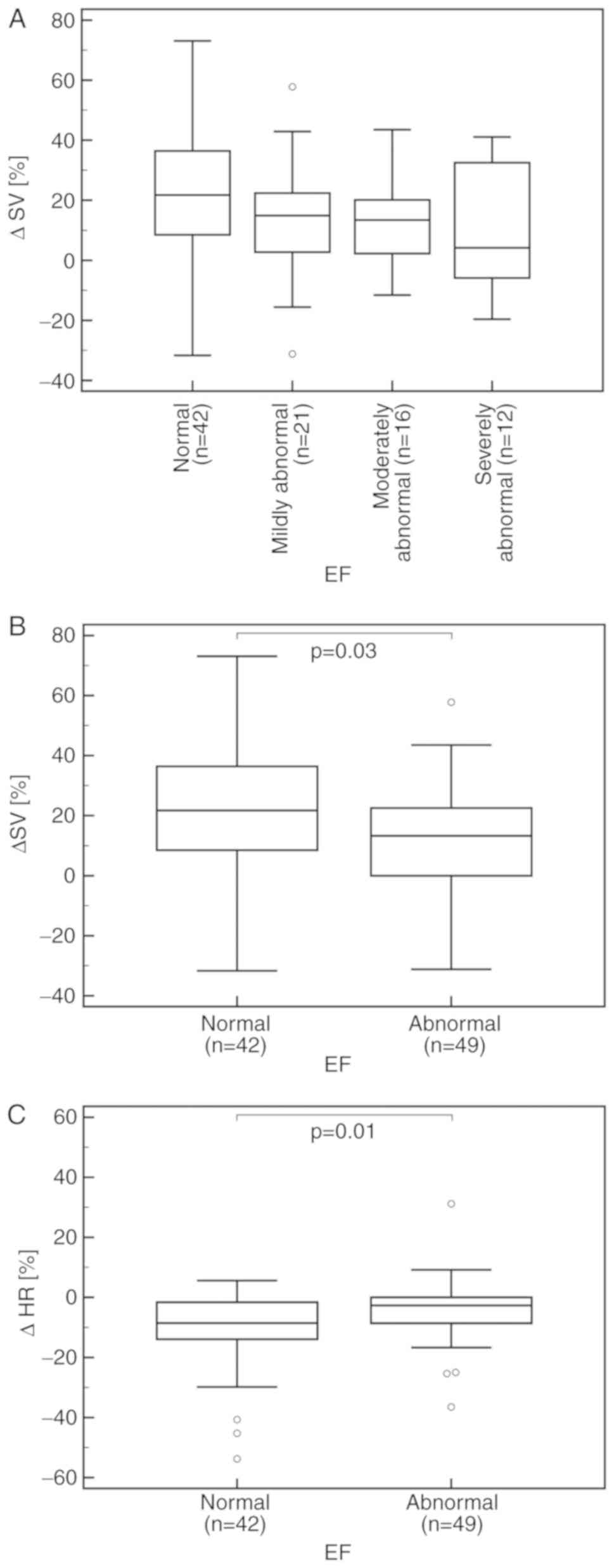|
1
|
Frank O: Zur Dynamik des Herzmuskels. Z
Biol (Munich). 32:370–437. 1895.
|
|
2
|
Starling E: The linacre lecture on the law
of the heart. London, UK: Longmans, Green and Co. 1918. View Article : Google Scholar
|
|
3
|
Smith JJ, Bush JE, Wiedmeier VT and
Tristani FE: Application of impedance cardiography to study of
postural stress. J Appl Physiol. 29:133–137. 1970. View Article : Google Scholar
|
|
4
|
Saur J, Fluechter S, Trinkmann F,
Papavassiliu T, Schoenberg S, Weissmann J, Haghi D, Borggrefe M and
Kaden JJ: Noninvasive determination of cardiac output by the
inert-gas-rebreathing method-comparison with cardiovascular
magnetic resonance imaging. Cardiology. 114:247–254.
2009.PubMed/NCBI View Article : Google Scholar
|
|
5
|
Agostoni P, Cattadori G, Apostolo A,
Contini M, Palermo P, Marenzi G and Wasserman K: Noninvasive
measurement of cardiac output during exercise by inert gas
rebreathing technique: A new tool for heart failure evaluation. J
Am Coll Cardiol. 46:1779–1781. 2005.PubMed/NCBI View Article : Google Scholar
|
|
6
|
Christensen P, Clemensen P, Andersen PK
and Henneberg SW: Thermodilution versus inert gas rebreathing for
estimation of effective pulmonary blood flow. Crit Care Med.
28:51–56. 2000.PubMed/NCBI View Article : Google Scholar
|
|
7
|
Dong L, Wang JA and Jiang CY: Validation
of the use of foreign gas rebreathing method for non-invasive
determination of cardiac output in heart disease patients. J
Zhejiang Univ Sci B. 6:1157–1162. 2005.PubMed/NCBI View Article : Google Scholar
|
|
8
|
Gabrielsen A, Videbaek R, Schou M,
Damgaard M, Kastrup J and Norsk P: Non-invasive measurement of
cardiac output in heart failure patients using a new foreign gas
rebreathing technique. Clin Sci (Lond). 102:247–252.
2002.PubMed/NCBI View Article : Google Scholar
|
|
9
|
Lang RM, Badano LP, Mor-Avi V, Afilalo J,
Armstrong A, Ernande L, Flachskampf FA, Foster E, Goldstein SA,
Kuznetsova T, et al: Recommendations for cardiac chamber
quantification by echocardiography in adults: An update from the
American Society of Echocardiography and the European Association
of Cardiovascular Imaging. Eur Heart J Cardiovasc Imaging.
16:233–270. 2015.PubMed/NCBI View Article : Google Scholar
|
|
10
|
Erbel R, Brennecke R, Goerge G,
Mohr-Kahaly S, Wittlich N, Zotz R and Meyer J: Possibilities and
limits of 2-dimensional echocardiography in quantitative image
analysis. Z Kardiol. 78 (Suppl 7):S131–S142. 1989.(In German).
PubMed/NCBI
|
|
11
|
Damgaard M and Norsk P: Effects of
ventilation on cardiac output determined by inert gas rebreathing.
Clin Physiol Funct Imaging. 25:142–147. 2005.PubMed/NCBI View Article : Google Scholar
|
|
12
|
Stefadouros MA, El Shahawy M, Stefadouros
F and Witham AC: The effect of upright tilt on the volume of the
failing human left ventricle. Am Heart J. 90:735–743.
1975.PubMed/NCBI View Article : Google Scholar
|
|
13
|
John JM, Haykowsky M, Brubaker P, Stewart
K and Kitzman DW: Decreased left ventricular distensibility in
response to postural change in older patients with heart failure
and preserved ejection fraction. Am J Physiol Heart Circ Physiol.
299:H883–H889. 2010.PubMed/NCBI View Article : Google Scholar
|
|
14
|
Dinh W, Füth R, Lankisch M, Hess G, Zdunek
D, Scheffold T, Kramer F, Klein RM, Barroso MC and Nickl W:
Growth-differentiation factor-15: A novel biomarker in patients
with diastolic dysfunction? Arq Bras Cardiol. 97:65–75. 2011.(In
English, Portuguese, Spanish). PubMed/NCBI View Article : Google Scholar
|
|
15
|
Hamm K, Trinkmann F, Heggemann F,
Gruettner J, Schmid-Bindert G, Borggrefe M, Haghi D and Saur J:
Evaluation of aortic valve stenosis using a hybrid approach of
Doppler echocardiography and inert gas rebreathing. In Vivo.
26:1027–1033. 2012.PubMed/NCBI
|
|
16
|
Saur J, Trinkmann F, Doesch C, Scherhag A,
Brade J, Schoenberg SO, Borggrefe M, Kaden JJ and Papavassiliu T:
The impact of pulmonary disease on noninvasive measurement of
cardiac output by the inert gas rebreathing method. Lung.
188:433–440. 2010.PubMed/NCBI View Article : Google Scholar
|
|
17
|
Saur J, Trinkmann F, Weissmann J,
Borggrefe M and Kaden JJ: Non-invasive determination of cardiac
output: Comparison of a novel CW Doppler ultrasonic technique and
inert gas rebreathing. Int J Cardiol. 136:248–250. 2009.PubMed/NCBI View Article : Google Scholar
|
|
18
|
Trinkmann F, Berger M, Hoffmann U,
Borggrefe M, Kaden JJ and Saur J: A comparative evaluation of
electrical velocimetry and inert gas rebreathing for the
non-invasive assessment of cardiac output. Clin Res Cardiol.
100:935–943. 2011.PubMed/NCBI View Article : Google Scholar
|
|
19
|
Trinkmann F, Sampels M, Doesch C,
Papavassiliu T, Brade J, Schmid-Bindert G, Hoffmann U, Borggrefe M,
Kaden JJ and Saur J: Is arterial pulse contour analysis using
nexfin a new option in the noninvasive measurement of cardiac
output?-A pilot study. J Cardiothorac Vasc Anesth. 27:283–287.
2013.PubMed/NCBI View Article : Google Scholar
|
|
20
|
Bubenek-Turconi SI, Craciun M, Miclea I
and Perel A: Noninvasive continuous cardiac output by the Nexfin
before and after preload-modifying maneuvers: A comparison with
intermittent thermodilution cardiac output. Anesth Analg.
117:366–372. 2013.PubMed/NCBI View Article : Google Scholar
|
|
21
|
Appel PL, Kram HB, Mackabee J, Fleming AW
and Shoemaker WC: Comparison of measurements of cardiac output by
bioimpedance and thermodilution in severely ill surgical patients.
Crit Care Med. 14:933–935. 1986.PubMed/NCBI View Article : Google Scholar
|
|
22
|
Franko E, Van De Water J and Wang X: Ideal
measurement of cardiac output: Is impedance cardiography the
answer? Vasc Endovascular Surg. 25:550–558. 1991. View Article : Google Scholar
|
|
23
|
Saur J, Trinkmann F, Doesch C, Weissmann
J, Hamm K, Schoenberg SO, Borggrefe M, Haghi D and Kaden JJ:
Non-invasive measurement of cardiac output during atrial
fibrillation: Comparison between cardiac magnetic resonance imaging
and inert gas rebreathing. Cardiology. 115:212–216. 2010.PubMed/NCBI View Article : Google Scholar
|
|
24
|
Trinkmann F, Papavassiliu T, Kraus F,
Leweling H, Schoenberg SO, Borggrefe M, Kaden JJ and Saur J: Inert
gas rebreathing: The effect of haemoglobin based pulmonary shunt
flow correction on the accuracy of cardiac output measurements in
clinical practice. Clin Physiol Funct Imaging. 29:255–262.
2009.PubMed/NCBI View Article : Google Scholar
|










